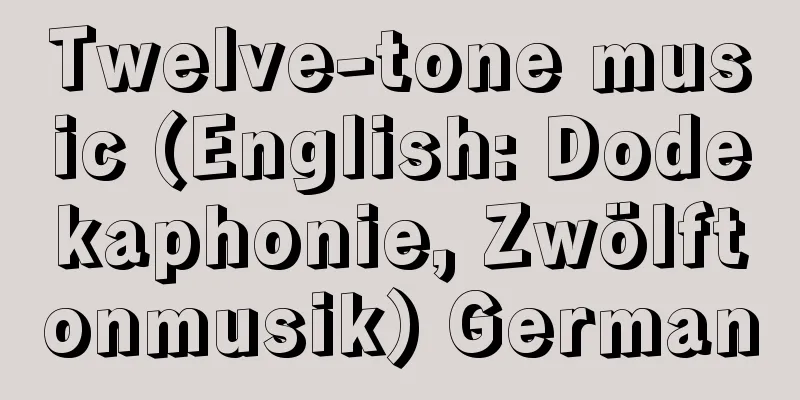Twelve-tone music (English: Dodekaphonie, Zwölftonmusik) German

|
Dodecaphony is a type of music that breaks down the hierarchy of tonal music by treating the 12 tones of the well-tempered scale equally. It was created by Josef Matthias Hauer and Schoenberg in the early 1920s, but chronologically, Schoenberg's style determined the music that followed. This compositional technique is called the twelve-tone technique. Schoenberg first tried this technique in 1923 in his Five Piano Pieces (Op. 23) and Serenade (Op. 24), and further developed it in the following year in Piano Suite (Op. 25). Specifically, the twelve-tone technique involves first creating a "tone sequence" (called the original form) in which each of the 12 semitones appears once, and then creating four forms: a retrograde form (tracing the original form backwards), an antithetical form (reversing the pitch), and an antithetical retrograde form (a combination of the two). In combination with a transposition form in which the starting tone is moved to each of the 12 tones, a total of 48 tone sequences are created, and music is composed using some of these tone sequences. Therefore, twelve-tone music can be said to be music that intertwines the tone sequences contrapuntally. Schoenberg's pupil Webern further theorised the division of tone rows and the determination of intervals, laying the foundation for the musique seriale that came after the Second World War. After Schoenberg's death, Stravinsky adopted the twelve-tone technique from his Septet (1952-1953) onwards. Krsenek and Dallapiccola had been composing twelve-tone music since before the war, but like Hauer, they left little impact. [Shuhei Hosokawa] [References] | | |Source: Shogakukan Encyclopedia Nipponica About Encyclopedia Nipponica Information | Legend |
|
平均律音階中の12音を同等に扱うことによって、調性音楽にみられた主音を中心とするヒエラルキーを崩壊させた音楽。ドデカフォニー。ヨゼフ・マティアス・ハウアーとシェーンベルクが1920年代前半に創始したが、年代記的にはやや後発のシェーンベルクの流れがその後の音楽を決定づけた。その作曲技法を十二音技法という。シェーンベルクは1923年の『五つのピアノ曲』(作品23)、『セレナード』(作品24)でこの技法を初めて試み、翌年の『ピアノ組曲』(作品25)でさらに展開した。 十二音技法とは、具体的にいうと、まず12の半音が一度ずつ現れる一つの「音列」(これを原形とよぶ)をつくり、その逆行形(原形を後ろからたどる)、反行形(音程の上下を反対にする)、反行逆行形(二つの組合せ)の四つの形をつくる。そして開始音を12のそれぞれの音に移した移置形との組合せで、結局48の音列をつくりだし、これらのうちいくつかの音列を用いて音楽を構成する方法である。したがって、十二音音楽はその音列の対位法的な絡み合いの音楽といえる。 シェーンベルクの弟子のウェーベルンは、音列の分割や音程の決定をさらに理論化し、第二次世界大戦後のミュージック・セリエルの基礎をつくった。またシェーンベルクの死後、ストラビンスキーは『七重奏曲』(1952~1953)以降、十二音技法を採用した。またクルシェネクとダッラピッコラは戦前から十二音音楽を創作していたが、ハウアー同様ほとんど影響を残さなかった。 [細川周平] [参照項目] | | |出典 小学館 日本大百科全書(ニッポニカ)日本大百科全書(ニッポニカ)について 情報 | 凡例 |
>>: Twelve Links - Twelve Links
Recommend
Caecilianus
…A Christian sect that arose in North Africa in t...
Triangular ruler
〘 noun 〙 A ruler that forms a triangle. Usually, t...
vernal conjunctivitis
…It is accompanied by severe itching along with r...
Ibouminina - Ibouminina
...It is common in northern Japan. B. zonalis is ...
Iburi Bay - Iburiwan
…It is also called Funka Bay or Iburi Bay. It is ...
Separation of Akakios - The division of Akakios
…In 484, the Church of Rome excommunicated Akaciu...
Ema Tokimori - Ema Tokimori
...Lord of Takahara-go, Yoshiki-gun, Hida Provinc...
Peacock turtle - Peacock turtle
…A turtle of the family Erymidae. It includes 12 ...
The Structure of Social Action
… Parsons' sociological theory is systematize...
Bonifacio de Andrada e Silva, José
Born: June 13, 1763, Santos Died April 6, 1838, Ni...
Veronica undulata (English spelling) Veronica undulata
… [Kei Yamazaki]. … *Some of the terminology that...
Neutral current - Neutral current (English spelling)
Gauge particles related to the weak interaction in...
Beeco
Italian historical philosopher and legal scholar. ...
Amount of substance
The mole is the amount of a substance expressed as...
Streamline - Ryusen
A curved line in a flow, the tangent of which at ...









